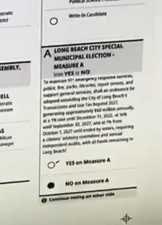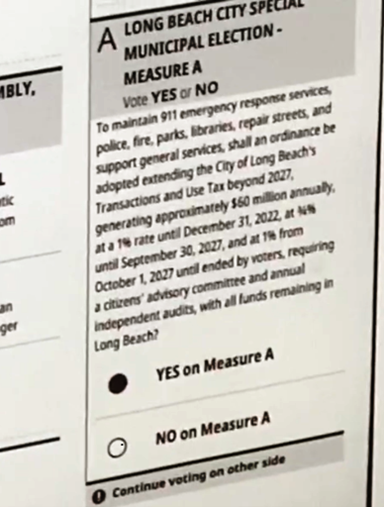Part 4 of a 4-part series
When the voter marks 2 votes in a vote-for-1 contest, or 5 votes in a vote-for-4 contest (etc.), that’s called an overvote.



The Los Angeles VSAP optical-scan voting machines are so eager to treat a mark as a vote, that they treat stray marks of the kind illustrated here as overvotes. When the voter intent is CRYSTAL clear to any human, we should not make excuses for the failure of machines to read them.
There are several ways that election officials could treat overvotes:
[Worst] Ignore the issue, don’t even report overvotes, just report number of votes successfully cast for each candidate and the total number of ballots. Presumably the difference is the total of overvotes and undervotes. Many jurisdictions use this method, which caused a lot of trouble in New Hampshire in 2020.
[Bad] Report overvotes separately from undervotes, then ignore the issue. That’s what LA does.
[Mediocre] Report overvotes separately from undervotes, then if there’s a significant overvote rate, use that information to start diagnosing what the problem might be.
[Good] Send all overvoted ballots for “adjudication”, which is a process of examining them to see if the voter’s intent can be determined. Many election offices do this. Most modern voting machines can assist with this process by either physically segregating overvoted ballots into a separate bin, or by collecting their pictures (electronic ballot images) for examination by an adjudication board.
Supporters of touch-screen voting like to point out that it’s practically impossible to overvote using a touchscreen interface. That’s true, but touch-screen voting has other significant problems of its own. In LA County, more than half the votes were mail-in/dropbox, where touch screens couldn’t have been used anyway. There were 88 overvotes in the Long Beach referendum, where the margin of victory was 16 votes. Observers of the recount say of all the overvotes they saw that the voter’s intent was very clear, and there was just a stray mark somewhere on (or just near) the other oval (vote target). It’s very possible that the recount would have changed the result of the election, if the recount hadn’t been too expensive to complete. But such an expensive solution (a recount) should not have been needed: LA procedures should have been designed to adjudicate those 88 overvotes by manual inspection.
Ineffective audits and willful disregard of voter intent in Los Angeles
California law since 1965 requires a 1% manual audit—that is, a hand count of 1% of the precincts in each jurisdiction. That style of audit is quite obsolete, compared to more efficient and effective methods such as Risk Limiting Audits, but even so, a 1% manual audit could tell us something. For example, they could tell us whether the voting machines are so miscalibrated that they treat the tiniest stray mark as an overvote.
Except that there seems to be something fishy about Los Angeles County’s 1% audits. The 1% audit conducted after the March 2020 election reported 100% accuracy after reviewing about 21,000 randomly chosen ballots. But if there’s an overvote rate of something like 88/100,000; and if practically all of those overvotes have a very clear voter intent (as was observed in the Long Beach recount), then one would expect about 20 overvotes per contest to be seen (and corrected) during the audit. In that case, the audit would not report “perfect” results, only “nearly perfect”. What seems to be happening instead, and what really did happen during the Long Beach recount, is that LA County officials insist on treating tiny stray marks as if they are real overvotes, they insist on ignoring the clearest of voter intent, to make their audits come out “perfect.”

Another reasonable option is for optical scan machines to reject overvotes (spit the ballot back to the voter), who, ideally with informed guidance from a poll worker, can choose to correct it, or direct the poll workers to cast the ballot anyhow, either by overriding the machine’s overvote check or by depositing the ballot in an auxilliary collection box.
That’s how it works in Cambridge, MA.
(This doesn’t resolve exactly what should happen if the voter chooses not to fix it, though.)
In the case of LA County, the issue wasn’t with the BMD (ballot marking device) generated ballots, produced at the polling place, since the software on the BMD terminals essentially does that, not allowing someone to make an over-vote. The issue was with VBM (vote by mail) hand-marked ballots.